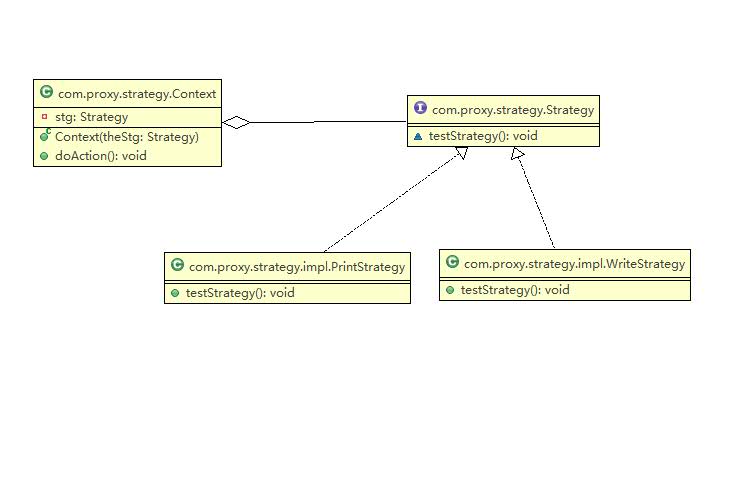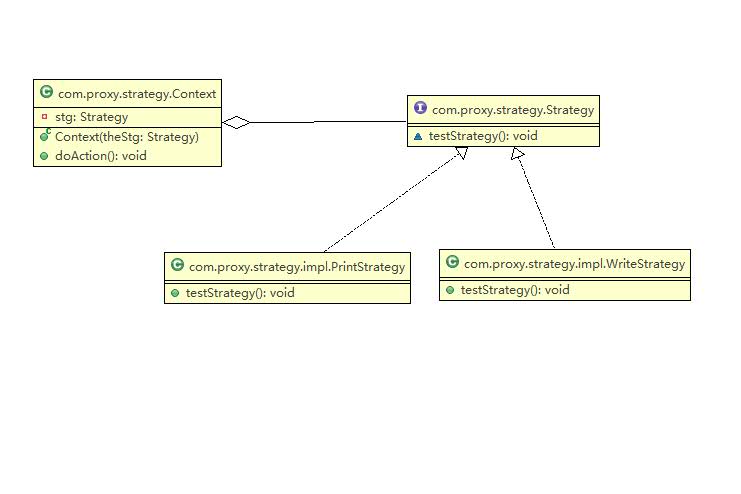1: Definition of Strategy Pattern
The strategy pattern is a packaging of the algorithm, which separates the responsibility of using the algorithm from the algorithm itself and delegates it to different object management. The strategy pattern usually packages a series of algorithms into a series of strategy classes, as a subclass of an abstract strategy class.
The class diagram is as follows:

If the strategy pattern is to be implemented using JAVA classes, the source code is as follows:
Java code
/**
*
* 策略执行
* @author weique.lqf
* @version $Id: Context.java, v 0.1 2014-2-9 下午2:32:56 weique.lqf Exp $
*/
public class Context {
private Strategy stg;
public Context(Strategy theStg) {
this.stg = theStg;
}
public void doAction() {
this.stg.testStrategy();
}
}Strategy interface:
Java代码
/**
*
*
* @author weique.lqf
* @version $Id: Strategy.java, v 0.1 2014-2-9 下午2:32:17 weique.lqf Exp $
*/
public interface Strategy {
void testStrategy();
}Implementation class one :
Java code
package com.proxy.strategy.impl;
import com.proxy.strategy.Strategy;
public class PrintStrategy implements Strategy {
public void testStrategy() {
System.out.print("我要打印!!");
}
}Implementation category two:
Java code
package com.proxy.strategy.impl;
import com.proxy.strategy.Strategy;
public class WriteStrategy implements Strategy {
public void testStrategy() {
System.out.println("我要写字!!!");
}
}Execution code:
Java code
package com.proxy.strategy;
import com.proxy.strategy.impl.PrintStrategy;
public class StrategyClient {
public static void main(String[] args) {
Strategy stgA = new PrintStrategy();
Context ct = new Context(stgA);
ct.doAction();
}
}Two: spring implementation strategy pattern
Now The system using spring can There are so many, so how to implement strategies in spring mode?
In fact, it only needs a little modification, because one of the cores of spring is IOC.
First modify the Contex class:
Java code
package com.proxy.strategy;
public class ContextSpring {
private Strategy stg;
/**
* Setter method for property <tt>stg</tt>.
*
* @param stg value to be assigned to property stg
*/
public void setStg(Strategy stg) {
this.stg = stg;
}
public void doAction() {
this.stg.testStrategy();
}
}Then configure it in the spring configuration file,
Xml code
<bean id="ct" class = "com.proxy.strategy.ContextSpring">
<property name="stg" ref="writeStg"/>
</bean>
<bean id="writeStg" class = "com.proxy.strategy.impl.WriteStrategy"/>
<bean id="printStg" class = "com.proxy.strategy.impl.PrintStrategy"/>Select the implementation class you want to inject, and then write this in the executed code :
Java code
package com.proxy.strategy;
import org.springframework.context.ApplicationContext;
import org.springframework.context.support.ClassPathXmlApplicationContext;
public class StrategySpringClient {
public static void main(String[] args) {
ApplicationContext context = new ClassPathXmlApplicationContext("Beans.xml");
ContextSpring ct = (ContextSpring) context.getBean("ct");
ct.doAction();
}
}Look, spring is introduced in this way.
But this has advantages and disadvantages. If I want to apply according to different types, for example: contracts need to be printed, while love letters need to be handwritten. Assuming that the contract is type 2 and the love letter is type 1, how do we automatically adapt?
Three: Advanced version of spring strategy mode
First modify the Context class:
Java code
package com.proxy.strategy;
import java.util.HashMap;
import java.util.Map;
/**
*
*
* @author weique.lqf
* @version $Id: ContextSpringFactory.java, v 0.1 2014-2-9 下午3:46:09 weique.lqf Exp $
*/
public class ContextSpringFactory {
private Map<String, Strategy> stgMap = new HashMap<String, Strategy>();
/**
* Getter method for property <tt>stgMap</tt>.
*
* @return property value of stgMap
*/
public Map<String, Strategy> getStgMap() {
return stgMap;
}
/**
* Setter method for property <tt>stgMap</tt>.
*
* @param stgMap value to be assigned to property stgMap
*/
public void setStgMap(Map<String, Strategy> stgMap) {
this.stgMap = stgMap;
}
public void doAction(String strType) {
this.stgMap.get(strType).testStrategy();
}
}Then modify the spring configuration file:
Xml code
<bean id="ctf" class = "com.proxy.strategy.ContextSpringFactory">
<property name="stgMap">
<map>
<entry key="1" value-ref="writeStg"/>
<entry key="2" value-ref="printStg"/>
</map>
</property>
</bean>The entry class modification performed For:
Java code
package com.proxy.strategy;
import org.springframework.context.ApplicationContext;
import org.springframework.context.support.ClassPathXmlApplicationContext;
public class StrategySpringClientFactory {
public static void main(String[] args) {
//外部参数
String type = "1";
ApplicationContext context = new ClassPathXmlApplicationContext("Beans.xml");
ContextSpringFactory ctf = (ContextSpringFactory) context.getBean("ctf");
ctf.doAction(type);
//type 2
type = "2";
ctf.doAction(type);
}
}Then run it and see what the results will be?





